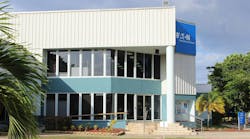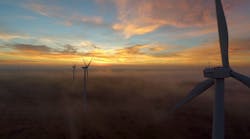California is Wild about Wind Energy
More than 50 square miles of California's wind-rich high deserts in the eastern part of the state may be developed into the world's largest wind-energy project. The proposed 1,500-megawatt (MW) wind farm would boost Southern California Edison's wind portfolio to 2,521 MW and be triple the size of any existing wind farm in the United States. Details of the project are still being worked out, but the capital investment is estimated at $2 billion to $3 billion, according to a recent report in Engineering News Record.
The U.S. wind energy industry installed 2,454 MW of new generating capacity in 2006, according to the American Wind Energy Association (AWEA), Washington, D.C. New wind farms boosted cumulative U.S. installed wind energy capacity by 27 percent to 11,603 MW, well above the 10,000-MW milestone reached in August 2006. One megawatt of wind power produces enough electricity to serve 250 to 300 homes on average each day. The AWEA says wind energy facilities currently installed in the U.S. will produce an estimated 31 billion kilowatt-hours annually or enough electricity to serve 2.9 million American homes.
Cold-Cathode Lamps Take Center Stage at Historic Cleveland Theater
Historic Playhouse Square in Cleveland is giving the cold-cathode lamps that light its marquee rave reviews. TCP Inc., Aurora, Ohio, donated 1,150 3W cold-cathode lamps to light the marquee of the Ohio Theater to replace the theater's current incandescent light bulbs. The estimated energy savings from the cold-cathode lamps is approximately $220 per month, adding up to more than $21,000 over the projected eight-year life of the lamps.
“The lamps use only about a quarter of the electricity used by the incandescent lights they replace, but actually look brighter,” said Brad Wiandt, TCP's national sales manager. “The cold-cathode lamps use only 3W, compared with 11Ws for the lamps they replace. The new lamps burn as long as 25,000 hours, versus the 750 to 1,000 hours for the typical incandescents.”
Another benefit for this particular installation is that cold-cathode lamps operate easily at lower wattages in colder temperatures, which was especially important to the theater management given Cleveland's typical harsh winters. Their longer performance life reduces the frequency of replacing the bulbs, which offers a dramatic impact on operations in terms of maintenance costs.
The Playhouse Square Center, in downtown Cleveland is the second-largest theater complex in the United States, second only to New York's Lincoln Center.
Now That's Something to Write Home about
An estimated 1,400 postal facilities in the New York, New Jersey and the Caribbean are going green, thanks to a massive retrofit job recently awarded to ConEdison Solutions (CES), an energy-service company (ESCO) based in White Plains, N.Y.
Under the program, ConEd Solutions, a subsidiary of the New York-based Con Ed utility, will identify and install energy conservation measures including renewable energy sources such as solar, wind power and geothermal heat pumps. Other system improvements could include such things as combined heat and power systems, HVAC equipment, building controls and lighting retrofits.
The contract, one of six such awarded under the postal service's Shared Energy Savings (SES) program, is part of a nationwide initiative to save $11 million a year in energy costs over ten years, for a total savings of $110 million. The six contracts have an estimated value of $1.3 billion. Participating companies will receive a percentage of the dollar savings attributable to the projects in return for assuming implementation costs.
The U.S. Postal Service, a charter client of ConEdison Solutions, has been a customer of the company since 1997. As of the end of 2004, the USPS had saved more than $5 million each year in energy costs through participation in CES programs.
Boston Announces New Green Building Standards
Boston made headlines late last year when the city's mayor announced a plan to incorporate LEED standards into its zoning code for large projects. According to a press release issued by Mayor Thomas Menino, Boston will become the first major city in the nation to require adherence to the U.S. Green Building Council's LEED (Leadership in Energy and Environmental Design) Certification standards as part of the private development review process. The new Green Building zoning provision will require that projects over 50,000 square feet meet a basic level of certification.
“High-performance buildings are the future,” Mayor Menino said. “As we continue to grow our city, we will do so in a way that is even more sustainable. Green buildings are good for the environment, public health, and the bottom line.”
World Trade Center Complex Will Go for LEED Gold Certification
The Freedom Tower and other buildings at the World Trade Center site will utilize some of the most energy-efficient building technologies available, according to New York Governor George Pataki.
“The redevelopment will be a global example of green building design and a constant reminder of our commitment to break the cycle of dependence on foreign energy,” said Pataki. “By moving forward with state-of-the-art design and guidelines, New York will once again show the world our ingenuity, innovation and commitment to building a stronger, brighter future for all.”
The Freedom Tower, World Trade Center Office Towers 2, 3, and 4, as well as the World Trade Center Memorial and Memorial Museum, will all be designed to achieve LEED Gold certification requirements, according to an announcement on the Web site of the U.S. Green Building Council (USGBC). These buildings join over 580 million square feet of building projects already involved with the LEED program, including World Trade Center 7, which was certified as LEED Gold in March of 2006.
“The decision to achieve LEED Gold is a fitting tribute to the importance of the reconstruction of Ground Zero,” said Rick Fedrizzi, president, CEO and founding chair, USGBC. “Using LEED sends a clear message that our buildings must not only be safe, but must also be healthy places for us to live and work. The World Trade Center buildings will stand as a symbol of New York's courage and commitment to a healthy and sustainable future.”
Governor Pataki also said the Freedom Tower and each of the World Trade Center office towers will use the latest fuel-cell technology to increase efficiency and provide secure, clean on-site power generation. These fuel cell installations, totaling 4.8 MW of power generation, will together constitute one of the largest fuel cell installations in the world.
The creation of a “green” World Trade Center site builds on the progress in Battery Park City, the neighborhood closest to the site. Battery Park City is home to The Solaire, the world's first green residential high-rise and LEED Gold building.
Bush Increases Funding for Renewable Energy in Fiscal 2008 Budget
Supporters of alternative-energy initiatives on Capitol Hill seemed to be pleasantly surprised with most of the funding increases proposed by President Bush for the U.S. Department of Energy in his 2008 fiscal year budget released earlier this month, according to an article posted on www.renewableenergyaccess.com.
According to the article, out of the $24.3 billion requested by President Bush for the U.S. Department of Energy (DOE) Fiscal 2008 budget, approximately $1.2 billion will be allocated to the Office of Energy Efficiency and Renewable Energy — up $60 million or 5 percent from 2007.
“We applaud the Administration for continuing to support the President's Solar America Initiative (SAI) at robust funding levels,” said Rhone Resch, president, Solar Energy Industries Association (SEIA). “At the same time, the administration's request funds solar water heating research at just $2 million and concentrating solar power at just $9 million. It's important that Congress recognize the vital contributions that these technologies can make to our energy security.”
According to www.renewableenergyaccess.com, the budget also calls for expansion in key energy programs that focus on developing clean and renewable energy, including $176 million for vehicle efficiency technology; $148 million for the Solar America Initiative (a major new R&D effort to achieve cost-competitive solar energy technologies across all market sectors by 2015); $213 million for hydrogen technology (includes fuel cell development); and $40 million for wind projects.








